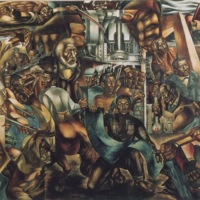![John Weber, Wall of Choices, Christopher Settlement House, N Greenview Ave and W Altgeld St, Chicago 1970 [destroyed], detail.jpg John Weber, Wall of Choices, Christopher Settlement House, N Greenview Ave and W Altgeld St, Chicago 1970 [destroyed], detail.jpg](https://486312.frmmmguz.asia/files/square_thumbnails/9fc1c6430ac66c245ed40da9a8d9ad6c.jpg)
Wall of Choices
In 1970, John Pitman Weber of the Chicago Public Art Group created a mural on the wall of the Christopher Settlement House on the north side of Chicago. The mural faces a children’s playground in a predominantly white working-class area of the city and according to Weber, the neighbourhood’s anxiety regarding racial tensions in the community only emerged during the creation of the mural and related discussions with local residents. Working together, Weber and the local residents agreed that the racial concerns needed to be surfaced, and the mural would serve this purpose. It depicts narrative scenes across the wall, including daggers and guns held by both black and white individuals, black hands in handcuffs under the phrase “free all political prisoners,” (something that the Black Panther Party was pushing for in the 1960s and 1970s), and a black hand shaking a white hand under the faces of Frederick Douglass and the radical white abolitionist John Brown, who are both identified on the mural as Freedom Fighters. The mural had been destroyed by the late 20th century.

The Contribution of the Negro to Democracy in America
In 1941, the artist Charles White was awarded $2000 from the Julius Rosenwald Fellowship for an ambitious project that included the creation of Contribution of the Negro to Democracy in America. Two years later, he unveiled the mural at the Hampton Institute in Virginia.The central figure has chains around his wrists that also loop around the necks of three other figures. But the shackles on the figure’s wrists are ready to be broken by the abolitionists: Frederick Douglass, Nathaniel Turner, Denmark Vesey, Harriet Tubman and Peter Still.